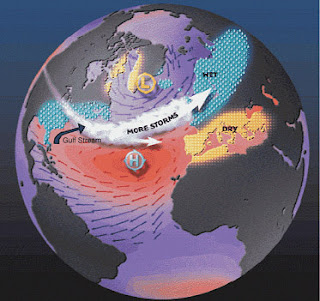Throughout this blog, we have been discussing what the current weather patterns and climate is for Prague, Czech Republic and the climate factors that affect this city. But what about what this city would have been like 100 million years go? Would the weather still be the same? Would the climate controls be the same? The answer to this is, no! The Earth 100 million years ago was a much different place then it is today. Not just because humans were non-existent, but because the earth's plates where in much different areas then they are presently. The map below, shows Earth how it is thought to be 100 million years ago with Prague denoted with the red circle around it.
 |
Europe 100 million years ago was not the body of land that it is today. Scandinavia was one large island, Italy its own, and multiple other countries made up their own islands in the Atlantic Ocean. The Czech Republic was itself its own island situated at about 40 degrees north longitude and 4 degrees east latitude compared to its coordinates today at 50°05"N longitude and 14°27"E latitude. Because Europe was not the large continent that it is today 100 million years ago, we can only speculate that this island was in fact the Czech Republic. It is very possible that the land that Prague sits on today, was buried under the sea. For educational purposes, we will assume that for this blog that this island was indeed the land that Prague is situated on today. (See current Prague climate graph below)
100 million years ago, Prague had much different weather. To begin, the centrally located city that it is today was, back then, situated on an island which brings us to the first major weather and climate change. Because of the land mass now being completely surrounded by water, the temperatures were much more warmer, there was much less variance in diurnal temperatures, and winters were much warmer than they are presently. As we know, water is the largest conductor of heat energy. During the day large radiation waves from the sun are emitted and absorbed by the water in the sea surrounding the island. This causes daytime temperatures to stay moderate to warm averaging around 83 degrees in the summer months down to around 65 degrees at night compared to a high of about 55 degrees in the winter during the day and 43 degrees at night for the low. (See climate graph below)
Prague was also a much wetter place then it is today because of the larger presence of the maritime tropical (mT) and continental tropical (cT) air masses that affected it. The presence of the mT air mass had the greatest effect on the island's weather which brought with it warm air but also the presence of precipitation especially during the winter months. Snow was nowhere around during these years as well due to the lack of the polar continantal and arctic maritime air masses seen today. Based on the Koppen-Geiger climate model, Prague 100 million years ago would have been classified as a warm temperate, dry summer, hot summer (Csa) climate. Much like most of the Mediterranean countries today.
What may be an even better question to ask is what Prague will be like 100 million years into the future. Just as no one knows for sure what it was like in the past, it is even more uncertain to determine what it will be like in the future. Based off of my observations, I have determined Prague's location in the future and denoted by the intersection of the red lines in the map below.
Based off of the video and map provided, I do not believe that Prague's location geographically will change very much, but it looks as though it may shift north-east. As the years progress, the continent of Europe is expected to collide with Northern Africa causing the Mediterranean Sea to disappear. This will cause great continentality among many of the countries currently affected by a lot of maritime air masses such as Spain and Italy. In Prague's case however, it will just increase the city's current continental locale.
I believe that Prague in the future is going to be much more affected by the continental polar and continental arctic air masses and much less, if at all, affected by the maritime tropical and maritime continental air masses because of its increasing continentality. This will cause diurnal temperatures to continue to fluctuate greatly and seasonal temperatures to be vastly difference as well. Snow in the winter months will also be slightly higher then they are now but due to the continued presence of the small mountain ranges surrounding the city, it still will not be a vast change. (See climate graph below)
Sources:
weather.com
http://www.youtube.com/watch?v=pGACbD4zbWs
http://www.cpgeosystems.com/105moll.jpg
http://www.youtube.com/watch?v=pGACbD4zbWs



























